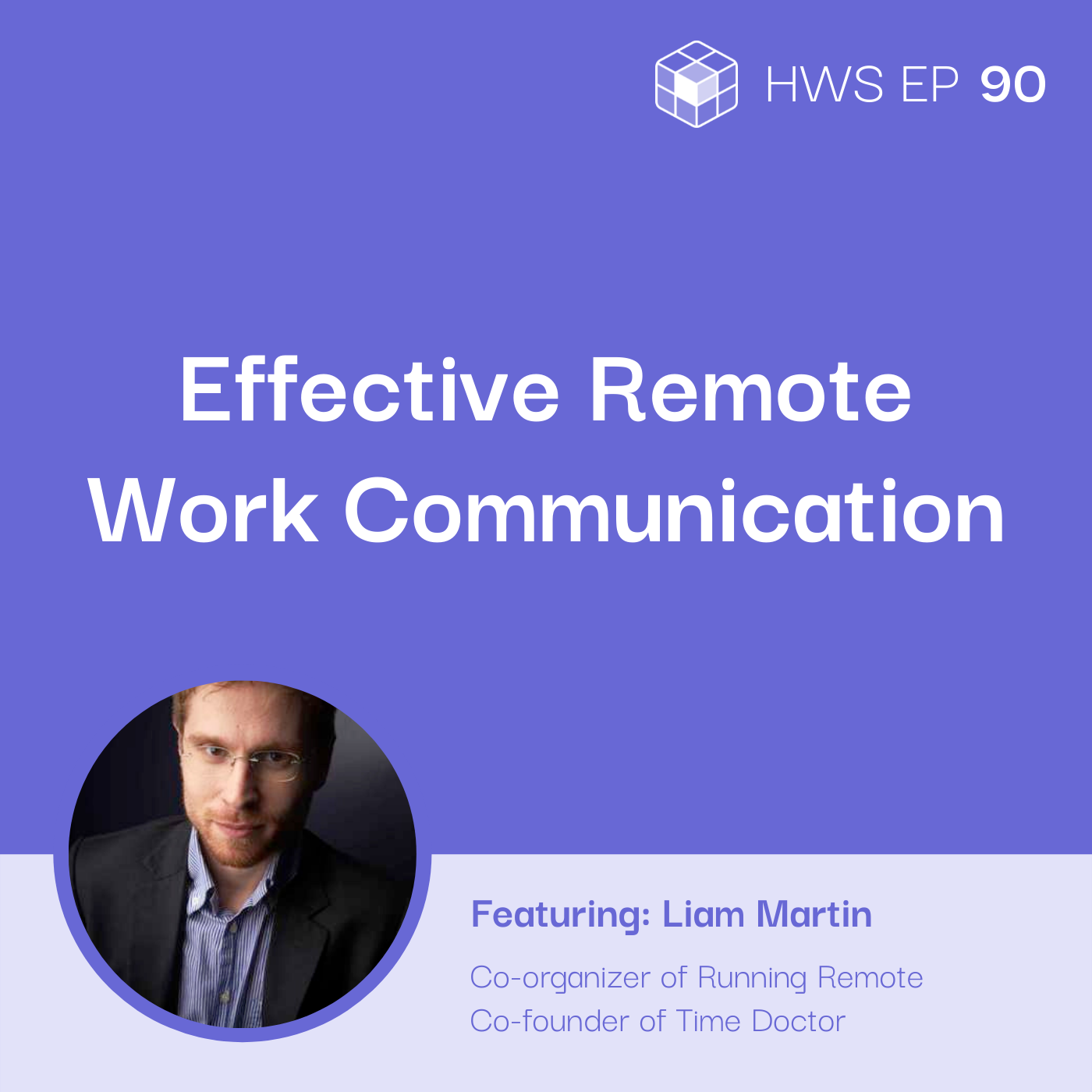Listen on:
Table of Contents:
Problem: How do newly remote companies communicate effectively?
Over the past year, millions of businesses have learned how to manage remote teams. For some, this paradigm shift has been a massive surprise. Some companies, particularly those already allowing some degree of remote working, have found the transition less difficult. If your company is suddenly operating remotely, this episode will help you answer the question, how do newly remote companies communicate?
Asynchronous organizations work completely differently. The person who’s listening to this podcast or watching this video right is now consuming this information asynchronously. Meaning, they can choose when they want to consume that information. And they’re not necessarily distracted. The concept inside physical offices is collaboration is always better. More synchronous, collaborative communication is always better. But, remote teams recognize that the opposite is true.
Asynchronous Communications is More Sustainable
Many people believe that recreating the office experience remotely will enhance team communication. Newly remote teams are notorious for constant communication — pinging whenever a request comes in, responding immediately, and going back and forth non-stop. This takes away from the quality time needed for deep work overtime.
For leaders and teams, Liam recommends these steps:
- Reduce meeting times and use these synchronous discussions efficiently and effectively by doing pre-work.
- Do deep work that helps you reach your growth goals.
- Conduct one-on-one conversations with your team to build better relationships.
- Build a culture of collaboration or use tools to speed up actions.
- Make people’s onboarding easier by documenting your processes.
- Send updates as part of your asynchronous communications; not during meetings
Step #1: Use Meeting Times Efficiently and Effectively
We often mistake presenting ideas during meetings instead of discussing important issues or making critical decisions that affect goals. We waste valuable time that we could have spent doing meaningful work. Liam offers some dos and don’ts:
- Numbers and reports should not be the focus of meetings. Unless there are issues buried within these reports that need immediate attention. In this case, the presenter should present these issues and initial ideas for solving them so that the rest of the team can weigh in and discuss them productively.
- Be careful how you present issues as well. Focus on the ones that will affect the team’s goals and KPIs. For instance, why is the sales team not meeting their targets, how can the team help them, etc.?
- If it’s just an update or something to say what you’ve done in the past month, you can use Loom or Big Yard to record your presentation.
I record it on Loom or Big Yard. Then, I take that recording. I put it into somewhere where everyone consumes that content. What I usually do is I have an issue connected to that particular presentation because just presenting a presentation, saying, ‘Hey, everyone watch this!’ To a degree, that’s usually pretty useless. You can actually get the same value directly from a report. What I want to figure out is the issue that we need to solve. Meaning, I’m having a particular problem with this particular issue connected to this presentation. And there are three different ways to solve it. How do we actually address that?
Step #2: Make Sure You Have Time To Do Deep Work
Focusing on a cognitively demanding task without distraction is deep work. With this skill, you can master complicated information quickly and get better results faster. You will become better at what you do with deep work, which provides a sense of genuine fulfillment. This will also help you scale faster. A meeting-filled day means you won’t be able to do any deep work.
The deep work methodology is the ability to be able to embrace deep work. This is how you build hyper-growth companies. Do whatever you can do, as the business owner, to open up those areas of restriction where people are maybe spending four to six hours of meetings per day. You can compress that down to an hour, 30 minutes, 15 minutes. It just opens them up to be able to do more deep work, which is the actual work that you need to operate and scale your business.
Step # 3: Conduct one-on-one conversations with your team to build better relationships
As soon as you’ve been cleared from endless meetings, make sure to invest time in understanding your team’s motivations and challenges. By understanding their personal and professional challenges, you can build a culture of trust. If they have problems, they can trust that they will be supported. If you want to build a collaborative culture, this is vital. It’s not about constant communication, but about having quality conversations.
And then that allows me to be able to only focus on what’s crucial, which is what issues are you having throughout your day? What are your issues with how your workweek is going? Are you having issues with some of your other team members? How can I unblock those barriers for you so that you can become more successful? It’s almost like I think about the emotional question. I try to reserve all synchronous communication for the EQ side, as opposed to the IQ side of a meeting. To me, that is much more rewarding. I get more stuff done, and we actually get down to the real issue. But more importantly, it solves your problem, which is people feeling heard and feeling part of a team.
Step #4: Build a Collaborative Culture or Use Tools To Speed Up Actions
Create a culture with a well-defined communication hierarchy. Know when to use tools such as instant messaging, audio, and video calls. Explore virtual offices to make experiences more collaborative even when you’re online.
The ability for you to move up is completely dependent on the barrier. So, if I’ve sent, let’s say 12 messages on Slack —back and forth —we’re still not coming to a conclusion, then I want to avoid going to an audio call. I want to go to a video call. I want to go to as granular as humanly possible because that solves the problem.
Step # 5: Make people’s onboarding easier by documenting your processes
When you work on an asynchronous schedule in different parts of the world, it’s important to have a well-documented operation and process to help new team members understand how the business works.
Everyone should jump into the process of documentation. There’s a bunch of other products in the market now. You can even just start with a Google Docs, but recording all the ways that you operate your business. This is another big part outside the management side of building and scaling a remote team, and training them, a way to be able to get started.
Step # 6: Send updates as part of your asynchronous communication; not during meetings
Reiterating the importance of doing deep work, Liam emphasized that synchronous time should always be about solving an issue. Whether it’s over chat, call, or meetings. If you have updates that are just part of housekeeping, send them over e-mail or collaborate using your project management tools.
If it’s just an update, honestly, the majority of the time, you don’t even need to produce a meeting for that. Go check out the Google doc and look at it. I don’t need to explain that to you. And if I do, you probably shouldn’t work here because, you know, you’re not up-to-date. Can you get that document? Or did you get that video? Do you see it? Then there’s an issue. And then we debate that issue. Usually in a project management tool. We use Asana.
Resources on Deep Work, Time Tracking, and Other Things Related to Remote Work:
- Deep Work, by Cal Newport
- Running Remote Resources, Blog, and Videos for new remote teams
- Time Doctor for Time Tracking
- Virbela Virtual Office
- Asana for Project Management
Do remote teams still meet face-to-face: We do it at least once a year. In our companies. So, we usually have a mini-conference about the company. Everyone flies into one location. We were going to do Mumbai in India last year for 2020. Obviously, that got canceled, like everything else. But everyone flies into one location, and we were going to do about four to five. Everything is connected to how the company operates, what we’ve accomplished last year, what we’re planning on doing the next year. And more importantly, what are the core issues that are holding us back from achieving our three-year five-year ten-year goals.
This interview is part of the How We Solve podcast. To hear more from industry experts who are solving everyday business problems, check us out on Spotify, Apple Podcasts, and on our website.
About the guest

Liam Martin
Believes that remote work is the future. His focus is to help move companies to a remote setup or scale remote organizations towards success. He co-organized the Running Remote, a professional online community for remote work leaders looking to connect with others, grow their teams and run their businesses remotely. He is also the co-founder of TimeDoctor.com, one of the world's leading time tracking software for remote teams.
How people can people reach the guest:
Website: Running Remote
LinkedIn: Liam McIvor Martin
Twitter: @RunningRemote
Podcast: Running Remote
Listen on:
